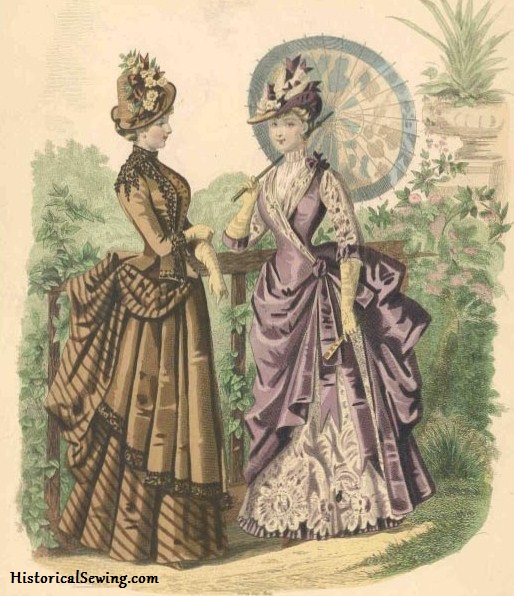Fashion Plate from La Mode Illustree, circa 1886

These lovely ladies are wearing such confections I just had to share! Since I don’t have the original magazine issue with the description of the plate I’ll list my own suggestions for how to make these costumes yourself.
Chocolate on Left: This is just so sophisticated and elegant. The stripes rock too! This design could easily be communicated into another color scheme very easily – like blues or greens. Even white with a red stripe – although this may take away some of the “in town” look and transfer it to the seaside or afternoon garden party. (Must have a different hat for that purpose.)
The design is crafted with a basic underskirt, a deep pleated apron and an overskirt in a short swag at the hip and softly falling in back. I’d try the apron with a full width of fabric, deep knife pleated to fit 2/3 of the waist then cut the length to the nice curve.
The bodice is identical to the Truly Victorian French Vest Bodice. For the shoulder epaulette trim, one idea is to use those pre-purchased lace collars and apply the beading by hand. Then find a similar lace to trim around the vest front, also hand applying beads.
This dress is obviously in silk. Although, a lovely cotton sateen could be used, or for a more practical garment, a moderate wool suiting with firm body.
Her hat is the VERY popular flower pot hat. There are a couple of vendors online that sell these hats, but if you want to make your own, try the one of the Truly Victorian 1880s hat patterns.
Lavender on Right: I love this dress! So cute and purple too! The lace as the oversleeves and as an overlay on the underskirt is simply divine.
This skirt, like the brown one, is also a basic underskirt with a narrow knife pleated ruffle (6-8″ deep) at the hem with the lace over it. That lace is probably the most expensive part of the dress so I’d only apply it around the front and sides ending at the center back panel/side back seam.
The apron is asymmetrical which is a design element of the late bustle period. Try your hand at draping this from a simple panel. Just note that the finished edge hanging from the left hip is cut on grain. The skirt back can be formed by using this simple bustling technique.
Her wrap front bodice is very fashionable for the late 1880s, a style that continues into the 90s. A plastron or chemisette fills in the neckline and décolleté.
As for fabrics, the lace would look best in an embroidered organdy or (silk) organza. A modern rayon Valencienne lace would also look lovely. The main fabric is a stunning silk taffeta. You could also use a lightweight cotton with shiny finish not unlike a polished cotton but not as heavy. Try a search at Farmhouse Fabrics for a delicate cotton.
Which of these two dresses do you like best? Post your thoughts below.


Hi Jennifer, I love your site and what you are doing. Making historic fashions would be fun. I’m glad I became your friend on FB. Thanks for sharing your fun and wonderful skills.
The Lavender ensemble, but what cross-over pattern would you suggest? I have never been able to find one! Thank you for the great tips.
Both gowns are beautiful, so how to choose? I like so much about each of them: the stripes and vertical lines of the chocolate and the lace, surplice, and color of the lavender. Yum to both!